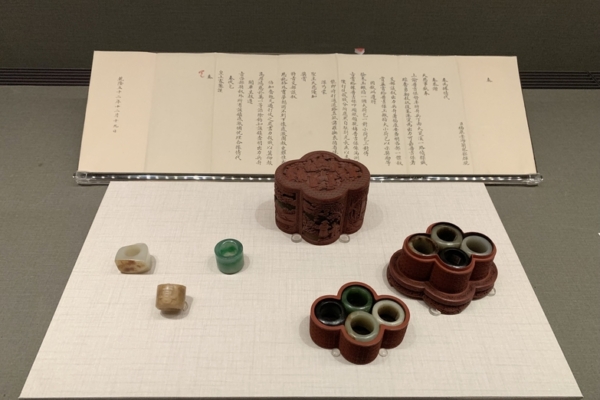【Epoch Times News, April 8, 2025】The National Palace Museum in Taiwan has launched a special exhibition titled “Grace and Courtesy – Imperial Gifts in Qing Dynasty Documents,” which will run until June 8.
This exhibition, hosted by the Taiwan Palace Museum, reveals the contents of the “highly confidential” memorials between emperors and officials through valuable historical materials such as memorials, documents, and files submitted by Qing officials. What kind of gifts did the emperors bestow upon their subjects? What stories were hidden behind them? Were the emperor’s gifts truly as extravagant as the imagined “rooms filled with gold and silver treasures”?
Xu Yuanting, curator and chief researcher of painting and calligraphy documents at the Taiwan Palace Museum, stated that the phrase “courtesy demands reciprocity” is well-known. “Courtesy” can be interpreted as being polite and respectful, or it can refer to material gifts. However, whether it is etiquette or actual gifts, their implications go far beyond the surface, especially the stories behind the items, which are worth delving into. Among the museum’s collection of cultural relics, there are certainly gifts bestowed by emperors to their subjects that reveal interesting discoveries that make people exclaim, “Ah! So this, too, is a gift?”
Xu Yuanting mentioned that the exhibition is divided into four major sections: “The Origins of Gifts,” “Promotions and Raises,” “Good Gifts Arrive,” and “Rewards and Punishments Done Right.” Through first-hand historical materials of officials expressing gratitude in documents, visitors can understand the imperial reward system of the Qing emperors. The emperor’s rewards were not limited to tangible gifts but also included promotions, honors, conferred titles, and posthumous edicts symbolizing honor and status, whose value often surpassed that of the gifts themselves.
Despite the emphasis on achievements, status, and honor, most rewards still primarily consisted of material gifts. However, these gifts were not as lavish as commonly imagined gold and silver jewelry but mostly practical items used in everyday life. From imperial inscriptions, calligraphy, books, papers, inkstones, folding fans, silk robes, to livestock, food, medicinal supplements; and even jade thumb rings, porcelain bottles, snuff bottles, agate boxes, and various currencies such as silver and ingots, the range of gifts was diverse.
According to the Taiwan Palace Museum, this exhibition showcases a selection of precious items bestowed by emperors, such as hats decorated with ornaments, cloisonné hairpins, famille rose porcelain hairpins, and a unique display of a set of twenty pieces of “Qing Qianlong famille rose imperial poetic floral snuff bottles,” allowing visitors a glimpse into the diverse array of gifts presented by the emperors.
Furthermore, the Taiwan Palace Museum stated that in modern times, people enjoy wearing rings on their thumbs to showcase their personality and fashion sense. This type of ring worn on the thumb was called a “zha” in ancient times, also known as a thumb ring, used to protect fingers from being injured by bowstrings during archery. Apart from its profound significance in preserving the tradition of Manchu equestrianism, under the active promotion and bestowal by Emperor Qianlong, the trend of wearing thumb rings became popular among Qing dynasty royalty, nobility, and officials as a symbol of personal status, making it one of the types of gifts bestowed by the emperor.
The Taiwan Palace Museum stated that to enrich the content of this exhibition, it specifically borrowed two precious relics from the National Museum of History. The “Guangxu Paper Merit Medal,” similar to today’s “commendation certificate,” was requested by Bao Chao, the then Governor of Yunnan Military Affairs and the First Viscount of Hunan (1828-1886), to be bestowed by Emperor Guangxu to Chen Yuan for his merits in military affairs, awarding him a “rank eight cap” and presenting a “merit medal” as a commendation.
The Taiwan Palace Museum noted that bestowing merit medals was not only a symbol of honor but often accompanied by promotion in official rank or the award of silver, representing another form of job promotion and salary increase. The “Imperial Double Dragon Precious Star” was inspired by the incentive system of awarding “medals” in various Western countries, initially used to reward foreign envoys, military officers, and merchants during diplomatic exchanges with Western nations, which later extended to Qing officials, becoming a part of the reward system in the Qing dynasty, showcasing the influence of Sino-Western cultural exchanges on the imperial court system.
“Giving gifts in the workplace is a profound art,” stated the Taiwan Palace Museum. How did the emperors determine who deserved rewards? And what gifts should be bestowed upon them? While these may seem like simple questions with no standard answers, clues may be found in the secret memorial system during the Kangxi era when officials covertly submitted memorials.
The “Wang Hongxu Secret Memorials” preserved in the Taiwan Palace Museum are correspondences between Emperor Kangxi and Wang Hongxu, a former Assistant Minister of the Ministry of Rites. This collection of secret memorials comprises 52 documents primarily written between 1705 and 1708, during Emperor Kangxi’s fifth Southern tour. They cover sensitive issues such as official corruption, bribery, and embezzlement, revealing the power dynamics of the memorial system and subtly hinting at the intricate social relationships involved in the “emperor’s gifts”.

